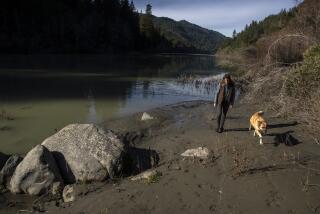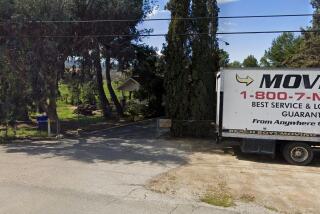Construction Unearths 200-Year-Old Remains : Archeology: Work will resume on the San Juan Capistrano project since there is no evidence of more artifacts there.
Workers digging a drainage ditch for a new business complex in San Juan Capistrano stopped work on Tuesday after finding bones from a 200- to 500-year-old American Indian man.
The remains are recent in archeological terms and there is no evidence of other bones or artifacts nearby that would disrupt construction, said work site archeological monitor Steve Dennis.
Dennis, who is observing construction at the Sycamore Commons site at Junipero Serra and Camino Capistrano roads, stopped work on the ditch Tuesday morning until Native American representatives decided their disposition. .
A backhoe had dug more than 12 feet down when Dennis spotted a fragment of bone about the size of a thumbnail at 7:50 a.m. He spotted a second bone, about 1.5 inches wide by 6 inches long, in the next load and a knobby bone in the third load. As the dirt from the fourth load cascaded down he spotted the femur. “Absolutely I knew it wasn’t an animal bone,” Dennis said.
Forensic anthropologist Judy Myers Suchey identified the remains and estimated their age, Dennis said. He said the sturdiness of the bones showed they weren’t very old. Other ancient human remains in Orange County have dated back thousands of years.
Dennis stopped work on the ditch immediately, and no other bones were found.
David Belardes, chairman of the Juaneno Band of Mission Indians, decided the bones would be buried nearby in a Juaneno ceremony, said Tom Tomlinson, planning director of San Juan Capistrano. He did not know when they would be buried.
At the main construction site, where two office buildings have gone up, workers found animal bones and shells that indicated the Indians ate there, Dennis said.
They also found a few dozen artifacts, including grinding stones and a granite mortar bowl that weighs about 40 pounds, Dennis said. They will be cataloged, analyzed and returned to the property owner, he said.
An American Indian village across the street was explored during the early 1980s by Cypress College professor Henry Koerper. He would not discuss his work, saying he is under contract with the same group that employs Dennis.
*
Times staff writer Janet Wilson contributed to this report.
More to Read
Sign up for Essential California
The most important California stories and recommendations in your inbox every morning.
You may occasionally receive promotional content from the Los Angeles Times.











